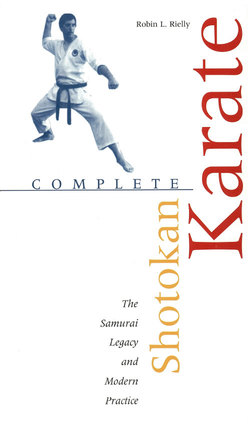Читать книгу Complete Shotokan Karate - Robin L. Rielly - Страница 9
На сайте Литреса книга снята с продажи.
ОглавлениеPreface
The writing of this book springs from two diverse interests on my part: one, an intellectual curiosity linked to my study of history and the other, a desire to explain more fully the philosophy of the arts that I have practiced for the last twenty-five years.
I have been more fortunate than many in that I have been able to study martial arts under some of the greatest contemporary masters. While in Japan I trained under Master Fumio Nagaoka, a top expert in Shin Kage-ryu jujutsu. I also benefited from the instruction given me by Eizo Onishi of the Koeikan School of Karate. Countless Japanese friends and other experts aided me in learning new techniques in both schools and left me with an unforgettable sense of camaraderie. Upon my return to the United States I was fortunate to become a student of Teruyuki Okazaki, one of the most famous Japan Karate Association masters and Chief Instructor of the International Shotokan Karate Federation. I have been his student since 1963. During the latter half of the 1960s, Master Okazaki was assisted in Philadelphia by two great Japanese national champions, Keinosuke Enoeda and Katsuya Kisaka. Their efforts on my behalf were significant, and I benefited greatly from their instruction. Yet I find that there is still much to learn and many techniques to be perfected.
In addition to providing technical and philosophical guidance for many years, Master Okazaki also read the manuscript and offered suggestions. Further help in that area was given by Glenn Rosenthal and my wife, Lucille, both of whom contributed greatly to the final product. My good friend Anthony Mirakian, foremost American expert on Goju-ryu karate, read the Okinawan section and provided valuable criticism in addition to his generous loan of many historical photographs.
Special thanks are due to Master Masatoshi Nakayama, Chief Instructor of the Japan Karate Association, for generously permitting the use of his calligraphy.
I am also indebted to John Kandes and Lucille Rielly for help with the photography. John Baatz, Thomas Finnerty, and Glenn Rosenthal consented to pose for the illustrations of the special sparring drills and the kata.
I owe a debt of gratitude to Professors Ardath W. Burks and Donald T. Roden of Rutgers University who, through the course of long discussions, gave me valuable insights into the nature of the samurai class and its ethos.
I must acknowledge a long-standing debt to two gentlemen who many years ago encouraged my academic attempts and have always been supportive. Professor Tadashi Kikuoka of the Institute of Far Eastern Studies, Seton Hall University, read the manuscript and offered valuable suggestions on the organization and content. Professor John B. Tsu provided early guidance that started me on the path to the study of history. To both I offer sincere thanks.
For their graciousness in granting me personal interviews, I would like to thank the following individuals: Masayuki Hisataki, Head Instructor of the Shorinji-ryu Kenkokan Karate Association; Roy Meyer, Regional Instructor for Gojukai Karate-Do U.S.A.; Anthony Mirakian, U.S. representative for Okinawan Meibukan Goju-ryu Karate; Teruyuki Okazaki, Chief Instructor of the International Shotokan Federation; Peter Urban, President of the United States of America Goju Association; and Gosei Yamaguchi, Chief Instructor of Gojukai Karate-Do, U.S.A.
Finally, I am indebted to the following individuals and institutions for the loan of illustrative materials listed below.
Anthony Mirakian: pp. 30, 34, 35, 37, 47
Philadelphia Museum of Art: p. 57 (Edmund L. Zalinsky Collection and gift of Mr. C. O. von Kienbusch); p. 58 (gift of Mrs. John D. Rockefeller); p. 63 (print purchased by subscription, supplemented by the Lola Downin Peck Fund); p. 77 (gift of Mrs. John D. Rockefeller) University Museum, University of Pennsylvania: p. 25
West Coast Karate Association: p. 41
The work that follows is my sole responsibility and any shortcomings are my own.
ROBIN L. RIELLY
Toms River, N. J.
